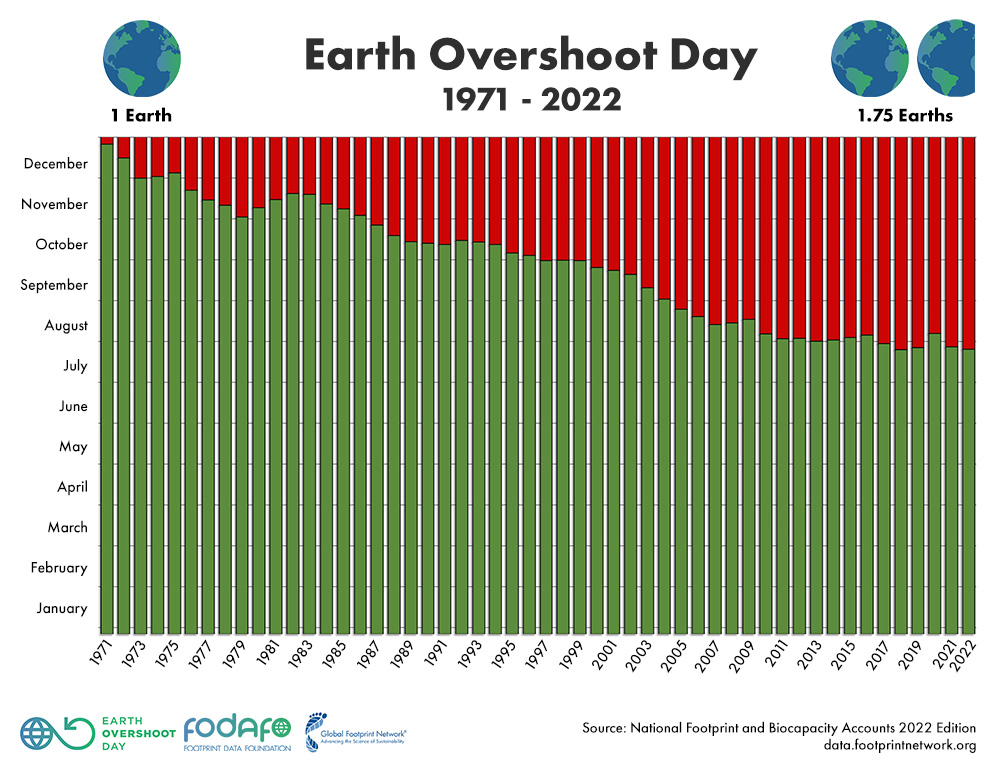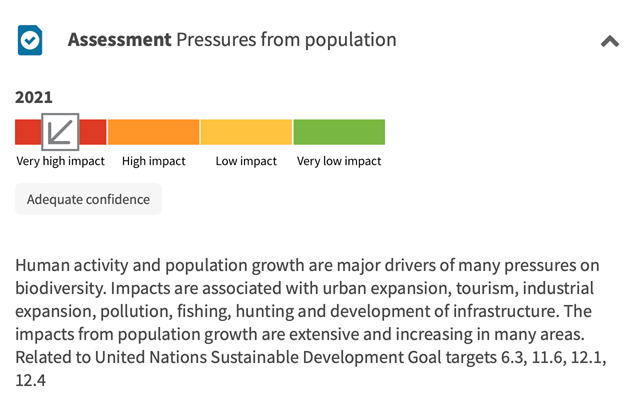Each year, Earth Overshoot Day marks the date when humanity has used all the biological resources the Earth regenerates during the entire year. Humanity currently uses 75 per cent more than the planet’s ecosystems can regenerate – or 1.75 Earths.
According to Earth Overshoot, 1971 would have been the final year in which human impact broke even with Earth’s carrying capacity. Back then, the global population was 3.8 billion. This year, Earth Overshoot Day falls on 28 July with a global population tipped to hit 8 billion by the end of the year.

The first Earth Overshoot Day was in 2006, but concern about limits to growth has been around for much longer. Some may recall the mainstream media attention on the issues during the 1970s, following the success of bestselling books The Population Bomb, by US scientist and author Paul Ehrlich, and Limits to Growth.
In the decades since, there has been very little attention in the mainstream media on limits to economic growth and post-growth alternatives that have been proposed, such as the steady state economy.
This is despite the fact that the evidence suggests we are on course for a worst-case scenario if we continue with ‘business as usual’ according to the projections made in the 70s. Globally, we are feeling the impacts now through supply shocks, climatic disasters, volatile markets and so on.
However, this has recently changed with the Australian State of the Environment Report 2021granted its eventual release this month. he former Coalition government has been accused of sitting on the release due to its sobering contents.
According to the report, climate change is exacerbating pressures on every Australian ecosystem. The number of listed threatened species rose 8 per cent since 2016 and more extinctions are expected in the next decades. The damage to the natural environment is such that it is now affecting the health and wellbeing of Australians.
This has been very evident across the east coast where drought and bushfires have been followed by intense flooding, destroying homes and lives. In Sydney, there have been four major floods in two years.
One surprising acknowledgement in the report was the contribution of human population growth to the pressures on the environment. In particular, it has a ‘very high impact’ on biodiversity.

In 1971, the final year in which the planet was not in overshoot, Australia’s population was 13 million. Just over 50 years later, our population has doubled toward 26 million. On the surface, this number may appear small by global standards. However, on a dry and fragile continent, every footprint makes a heavy impact.
The overview of the State of the Environment Report says: “Population, climate change and industry each put pressure on our environment. When combined, the threat increases and our environment is damaged, sometimes destroyed.’
The report says: “Increasing urban density as well as urban sprawl puts pressure on the natural environment and heritage.”
The biggest pressure on biodiversity is the clearing of native vegetation and the primary drivers of that are expansion of land dedicated mainly to agriculture and, to a lesser extent, forestry and infrastructure, including urban development.
If we can accept the uncomfortable truths presented to us by the State of the Environment Report and by Earth Overshoot Day, how do we move forward from here?
Here are some ideas.
Individual lifestyle changes are important (but not the whole story)
Per capita, we are among the world’s higher polluters, while we also enable the per capita emissions of other countries courtesy of the coal export industry. In 2019, Australia was emitting 15.24 metric tonnes of CO2 per capita. Globally, per capita emissions need to be more in the ballpark of 1.6 tonnes, at current global population (e.g. this will need to go down further if world population continues to grow).
There are many individual changes we can make. These are as varied as reducing the number of flights per year, driving less and taking public transport, eating lower on the food-chain and even using less refrigeration at home.
Australia’s per capita emissions have trended downward in recent years. Several factors have contributed to this. The COVID lockdowns put the brake on many lifestyle options, including plane travel. More recently, the price of housing, food and fuel have shot upward and that has necessitated frugality for many of us.
It is worth reflecting that many in the environmental and social justice movements prioritise their focus toward the consumption habits of richer countries. It is true that there are huge discrepancies between richer and poorer countries. However, Australia’s current market-based economy is not a good system in which to adjust our lifestyle patterns.
That’s because the main levers the market uses are adjustments to the price of goods and services. This disproportionately targets the poor, marginalised and younger generations by pricing them out of society without instigating the structural changes within society that would allow all of us to live more sustainable lives.
We need a systemic change from a profit-driven economy to a wellbeing-oriented economy in order to enable a rapid transition to a lower consuming society.
Don’t forget the impact of population
Population is a controversial issue that the politicians and the media like to hide. Mainstream reporting will tend to ignore or gloss over ‘population’ when discussing the findings of the State of the Environment Report and Earth Overshoot Day, despite population being a critical component in the jigsaw.
In a recent discussion paper from Sustainable Population on Population and Climate Change, the authors point out that climate mitigation models show sufficient emissions reduction cannot be achieved unless the model scenarios assume a rapid peak and decline in global population. Further, while Australians have recently reduced their per capita emissions a little, annual total greenhouse gas emissions from energy have risen 49 per cent since 1990 due entirely to population growth of 8.3 million people.
Somewhat ironically, in wealthier countries such as Australia, the decision to have one less child has a far greater impact on our carbon emissions than a host of lifestyle changes.

As it turns out, Australians have generally chosen to have smaller families for many reasons with our current fertility rate averaging just under 1.8 births per woman. Unfortunately, since the Howard era, each successive federal government (under the influence of the ‘Big Business’ lobby) has perpetuated a culture of ‘Big Australia’ by boosting population growth through economic migration. This has seen our population rapidly expand from 18.9 million in 2000 to nearly 26 million in 2022.
At our peak, we were growing toward 2 per cent per year, well above the OECD average annual population growth rate. In 2019, Australia grew by nearly 400 000, or the equivalent size of a new Canberra.
The ‘Big Australia’ dream does much for the temporary profits of big business while doing little for refugees and asylum seekers who make up a very small proportion of our migration program. As the latest State of the Environment Report attests, this population growth has also been disastrous for the natural environment on which our very lives depend.
Technology and innovation won’t save us (on their own)
In response to environmental crises, the mainstream media have a tendency to interview so-called ‘experts’ who claim that technology can save us and that we can innovate our way out of our predicaments.
The problem is that Australia has not been an innovative country for quite some time. In recent decades, the majority of our economy is reliant on the export of raw material and speculation of property prices. In regard to the latter, almost a million properties now lie vacant throughout the country, however new land release development persists.
It appears that we have not learnt from the succession of natural disasters that have destroyed homes and lives. Quite the opposite; the NSW government has deregulated the property sector even further, allowing property developers to release new land on known floodplains.
The environmental sector places much hope in the ‘green new deal’ or a future run by renewables. However, this can only go so far in a society that relies on perpetual population growth demanding further unnecessary overdevelopment. It doesn’t matter how many solar panels one places on a new house, every new development paves over land that once belonged to native plants and animals, land that is now lost forever.
Bottom line
Until recently, the predominating narrative has been that climate change and environmental deterioration were far-off phenomena that would affect far-off future generations. However the State of the Environment Report 2021 suggests we are feeling the effects now and leaving a precarious legacy for the future liveability of our children and grandchildren.
Earth Overshoot Day is a wake-up call that neither our economy nor our numbers can continue to grow infinitely on a finite planet. We must recognise the important role of population sustainability and work together to hold our government accountable.
Michael Bayliss is communications manager for Sustainable Population Australia (SPA). SPA is the ONLY environmental NGO in Australia highlighting the importance of population sustainability domestically and globally. Consider supporting our important cause. Read our media releases in response to the State of the Environment Report 2021 and for Earth Overshoot Day.

